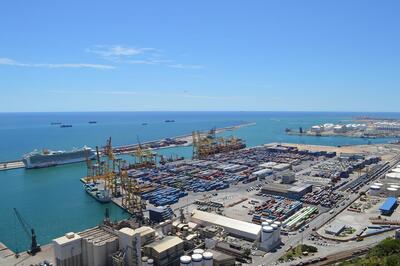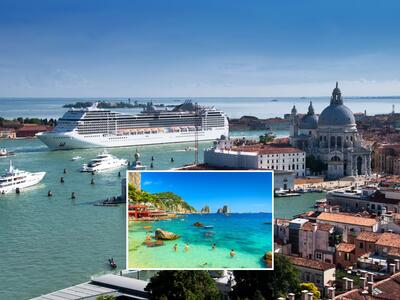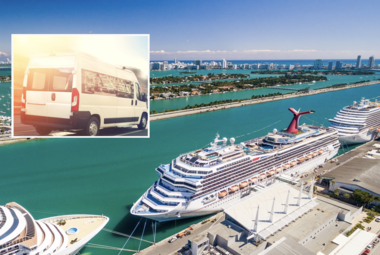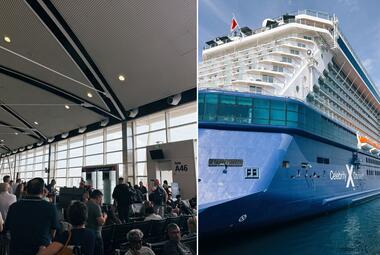Though there are year-round sailings to Europe, the peak of the European cruise season falls in the late spring, summer, and early fall.
Compared to the Caribbean, those embarking on a European cruise are more focused on sightseeing, versus lounging in a chair on the lido deck or snorkeling in the crystal-clear waters. Additionally, the itineraries are more diverse. While those sailing to the Caribbean are seeking a warm-weather getaway, a European cruise could be comprised of sailing through the dramatic fjords of Norway or island hopping in Greece.
Before booking a cruise that likely requires extensive pre-cruise travel, it's important to know what to expect and plan accordingly. European cruises in May differ from those in October, regardless of which region you're sailing to.

The ideal time to cruise varies based on factors like crowding, weather, and destination, meaning that the perfect month for your travel party may differ from a coworker's. If, for instance, you're a fan of milder temperatures and fewer crowds, you'll prefer a European cruise in the shoulder season, ideally in the spring or fall.
Overall, the worst months to cruise to the Mediterranean and Greek Isles are June, July and August

Typically, when one thinks of a European cruise, they do not envision sailing to colder weather destinations. Though itineraries to places like Iceland, Greenland, and Norway are popular, the majority of European cruises sail throughout the Adriatic and Mediterranean where the temperatures in destinations like Athens, Rome, and Barcelona soar into the high 80s and 90s in the summer.
While the Bahamas and Caribbean have similar temperatures, it's easier to bare hot weather when you're lounging on the beach and relaxing in the onboard pool. In contrast, exploring historical sites in sweltering heat is more challenging. If you have to cruise during the warmest months due to scheduling conflicts, take precautions to stay comfortable and safe.
Lightweight, breathable clothing will help keep you cool while drinking plenty of water will ensure you don't get dehydrated. It's also smart to take breaks in shaded areas whenever possible. Those who are prone to overheated may benefit from early morning excursions that avoid the peak heat of the day. If, however, that is not an option, consider water-based tours, such as a sailing tour in Mykonos.
Read more: I’ve been on 10 European cruises, and I see people making the same 12 mistakes

In addition to high temperatures, the summer months see an increase in land tourism. With cruise ships sailing at, or very close to, full capacity and an influx of land-based travelers, you'll be greeted by large crowds at popular sites such as the Vatican, Parthenon, and Pompeii.
With so many other passengers interested in seeing the same sights, ship-sponsored shore excursions tend to book up quickly, especially in cities where the ship docks far away from the main attractions, including Rome (Civitavecchia), Florence (Livorno), and Paris (Le Havre).
If you plan on forgoing ship-sponsored excursions, do plenty of research to ensure you're booking with a reputable company that will provide a well-organized experience without jeopardizing missing the ship's all-aboard time.

August is one of the busiest months, as this is when Europeans tend to plan their vacations. If you're cruising to somewhere in southern Europe, such as France or Greece, plan to encounter higher crowds than sailings in June and early July.
An increased demand in tourism comes with higher prices, regarding both cruise fares and plane tickets. Due to the school calendar, a lot of families cannot sail during the shoulder season and have to plan their summer vacations for June, July, and early August. Even those without children may be bound to the summer months due to their work schedules. My finacée, for instance, is an elementary school teacher, so it's harder for us to travel during the spring and fall.
When browsing Disney Cruise Line's itineraries for summer 2025, a 7-night Mediterranean cruise from Barcelona aboard the Disney Fantasy starts at $4,730 for two passengers in an inside cabin in May. The same itinerary increases to $6,815 in July.

Read more: 16 easy ways to save money on a Disney Cruise
Similarly, sailing onboard MSC World Europa in October 2025 costs around $870 per person when cruising in an inside cabin. Those who opt to cruise in July or August, however, will see fares as high as $1,309 per person.
It's not uncommon to see higher airfare prices, either. Living in Charlotte, NC, flying to places like Rome in June, July, and August often costs around $1,200. Direct flights typically cost more, with American Airlines charging a whopping $1,600 per person. If you're like me and like to use credit card points or airline miles to help offset the cost of airfare, you'll want to book your cruise in advance, as reward tickets are limited and tend to sell out months before the departure date.
My finacée and I used about 90,000 American Express points to book a one-way flight to Athens on Iberia in October 2023 for our July 2024 cruise aboard Celebrity Ascent. Even with points, we still had to pay $1,200 per person for a return flight, as there weren't any available reward seats on flights from Rome to Charlotte when we booked 9 months in advance.

In addition to enjoying fewer crowds during the shoulder season, the lower fares can help you maximize your vacation budget, as you can splurge on shore excursions or cruise add-ons like drink packages, Wi-Fi, spa treatments, specialty dining, and more.
Compared to The Bahamas and Caribbean, excursions tend to be more expensive. While you can often book an ATV tour for $150 per person or a snorkeling adventure for less than $100 each, excursions to places like Sorrento, Italy from Naples can cost upward of $300 per person, so saving money on the fare can help offset the higher excursion prices.
The best months to cruise to the Mediterranean and Adriatic are May, early June, and September

May, early June, and September tend to see lower prices and fewer crowds compared to the busy summer months. As many children are still in school, there's less of a demand for cruising, as well as land-based travel.
Plus, you'll still have plenty of choices when it comes to ship selection, as the majority of mainstream cruise lines begin their season deployment in Europe around April and May, with the season concluding as late as November.
Though the shoulder season months typically see cooler temperatures, it is never a guarantee. When I sailed to Europe the first week of June in 2023, I was taken aback by how warm it was in Rome, especially as I had spent a week in mild London the week prior. I was just as surprised when I disembarked in breezy Ibiza to cloudy skies, making it far too chilly to enjoy the beach as I had hoped.
Read more: I boarded my first European cruise. How different is it from a USA cruise?
Northern Europe is a tad different. Rather than seeing favorable conditions in the spring and early fall, you'll want to book a cruise in June, July, or August

While you'll find more cruises to the Mediterranean and Adriatic, you shouldn't immediately disregard sailings to Northern Europe. Cities like Amsterdam, Reykjavik, Zeebrugge (Brussels), and Alesund have their own unique charms and attractions. From the historic canals in Amsterdam to the natural wonders in Iceland, Northern European cruises feature stunning landscapes and vibrant cultural experiences.
That said, the weather is far more unpredictable than in southern Europe, meaning the shoulder season can often come with unfavorable conditions. Though the cruise fare in the early and late season is undoubtedly more affordable, those embarking on a once-in-a-lifetime sailing may prefer to wait until June, July, or August when there tend to be sunnier skies and warmer temperatures.
If you wait until the latter portion of the season, you will find far fewer itineraries, as many mainstream cruise lines pull their ships in October to reposition them to warmer climates. In July 2025, for instance, Norwegian Cruise Line offers 14 different itineraries to Northern Europe, ranging from a 9-night cruise aboard Norwegian Sky to a 14-night sailing onboard Norwegian Star, whereas the number decreases to 8 in October and just one in November.
Regardless of when you sail, don't forget to purchase travel insurance

Even the most well-thought-out vacation can take a turn for the worse due to unforeseen circumstances. Just as you have insurance on your home and car to protect those valuable investments, the same should be done for vacations. Though not the same as a traditional financial investment, cruises can provide personal and emotional benefits that contribute to your overall well-being.
Whether you're cruising during the shoulder season or splurging on a suite during the peak season, you can protect your investment with travel insurance, which will provide peace of mind in the event there's a sudden death in the family or your airline loses your luggage en route to your final destination.
Rather than have to shell out extra money at a moment's notice, insurance will allow you to enjoy your vacation without worrying about financial setbacks.
Read more: Man was sick on a cruise and was hit with a big bill before being sent home








